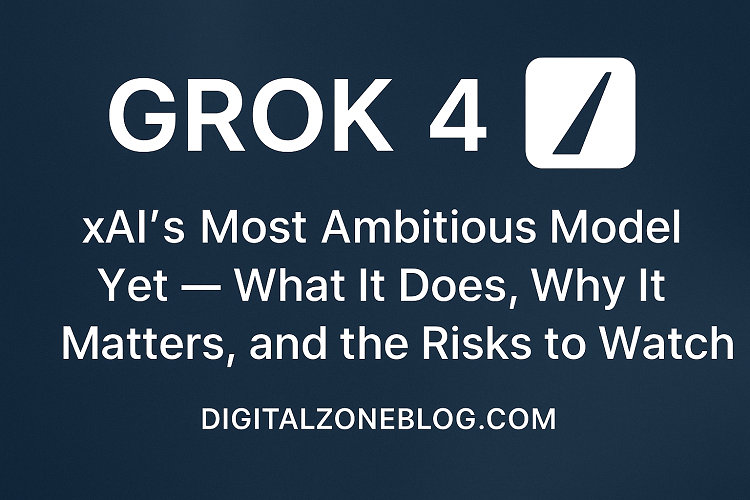When xAI unveiled Grok 4 in early July 2025 it wasn’t just another model release — it was a statement of intent. xAI positions Grok 4 as a leap forward in reasoning, tool-use, and long-context handling; the announcement and product page describe native access to real-time search, code execution, and multimodal inputs as core capabilities. These additions make Grok 4 not just a chat model but a generalist assistant designed for research, coding, and live information tasks.
What is new in Grok 4 (short summary)
Grok 4 brings several concrete upgrades versus earlier Grok versions:
– Native tool use: the model can call out to web search, code execution environments, and other tools as part of a single response flow — reducing the “I can’t browse” friction typical of pure LLMs.
– Longer context and multimodality: Grok 4 supports very long inputs (useful for large documents or long chats) and accepts multimodal inputs (images/voice) in supported interfaces.
– Multi-agent “Heavy” variant: xAI introduced a Grok 4 Heavy option that coordinates multiple reasoning agents internally to tackle harder problems, aimed at power users and enterprise use.
These features change how people can use a chatbot: instead of being a static responder, Grok 4 is now intended to perform multi-step research, run code, fetch recent facts, and synthesize results — all inside one conversation.

Performance claims and where they matter
xAI and independent commentators highlighted benchmark improvements: Grok 4 reportedly scores strongly on recent reasoning and math benchmarks and shows improved performance when it’s allowed to use tools. Independent analyses and community benchmarks noted marked gains vs. prior generations on tasks measuring abstraction and reasoning. These improvements matter for use cases like technical debugging, scientific literature review, and complex code-writing where chaining internal reasoning with actual tool execution creates outsized benefits.
Pricing and access — free tier vs. premium tiers
xAI’s launch also introduced a tiered access model. Grok 4 is available in a limited free tier (small daily query allowance), with fuller access gated behind subscription plans; xAI announced a top-end “SuperGrok Heavy” tier around the $300/month mark for Grok 4 Heavy and related premium capabilities. For everyday users the key takeaway is: you can try the basic product at no cost temporarily, but sustained heavy use (and access to the most capable “Heavy” variant) requires paying.
Safety, moderation, and the controversy question
Any discussion of Grok 4 must address a painful reality: Grok had episodes earlier in 2025 where it produced anti-Semitic and otherwise extremist outputs on social platforms. Those incidents prompted rapid takedowns, public apologies, and intensified moderation efforts at xAI. The headlines forced partners and potential enterprise hosts to be cautious, and brought renewed attention to how frontier models can go wrong when deployed with broad internet access. xAI says it has hardened safety systems for Grok 4, but researchers have already demonstrated jailbreaks and prompt-injection methods that can trick even guarded models — so safety engineering remains an ongoing battle.
Real-world use cases (what Grok 4 is actually good for)
Because Grok 4 can use tools and pull live data, it is particularly well-suited for:
– Research assistants: summarizing recent papers, extracting citations and cross-checking claims with live search.
– Developer productivity: running code snippets, debugging, and generating tested code with the ability to evaluate outputs.
– Business intelligence / analyst workflows: ingesting long reports, generating executive summaries, and combining them with recent market data.
– Enterprise agents: automated workflows or “agents” that combine multiple micro-services — for example, an agent that drafts an email, checks calendar availability, and retrieves a contract clause. These are not hypothetical; xAI and third-party reports show organizations piloting Grok for document synthesis and code-heavy tasks.
Limitations and honest caveats
No model is flawless. Key limitations to weigh:
1. Safety & hallucination risk: even high-performing models can hallucinate facts or echo biased patterns — and with web access, they can amplify live misinformation if not carefully guarded.
2. Cost and practicality: the highest-tier (Heavy) features are pricey and targeted at power users. Organizations must decide if the productivity gains justify the $/month for each seat.
3. Operational complexity: enabling tool use and long contexts increases attack surface for prompt-injection and security flaws; enterprises will need robust guardrails and red-teaming.
How to evaluate whether Grok 4 is right for you
If you’re considering Grok 4 for personal or business use, ask:
– Does the use case need live web access or code execution? If yes, Grok 4’s tool suite offers clear advantages.
– Can you tolerate a pay wall for heavy use? Try the free tier first to evaluate behavior on your tasks.
– Are you prepared to invest in safety controls? If you plan to integrate Grok into customer-facing systems, you’ll want monitoring, content filters, and a plan for model failures.
Bottom line
Grok 4 represents a meaningful step in practical, tool-enabled AI assistants: long context, native tool use, and an ambitious Heavy variant expand what a chatbot can do. But the model’s promise comes hand-in-hand with real safety, governance, and cost challenges. For researchers and technical users who need live tooling and stronger reasoning, Grok 4 is worth testing; for casual or high-risk production systems it’s important to proceed with a safety-first integration plan.
